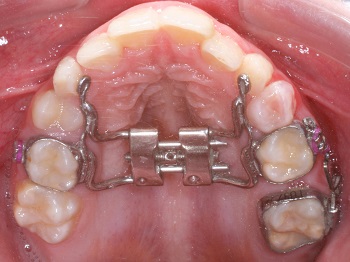Vol. 15 – Number 57 – 2022 Column Point of View Page 15-18 How to distalize the upper first permanent molar in the mixed dentition anchored on a palatal dysjunction appliance? Ivan Toshio Maruo1 Armando Yukio Saga1 Ivan Pedro Taffarel2 Mohamad Jamal Bark3 Orlando Tanaka4 Introduction Interceptive orthodontic procedures, when correctly indicated, can have a positive impact on patients¹. Rapid maxillary expansion (RME) is a routinely interventional orthodontic procedure routinely used because it has several indications². Haas³ described that the effects of RME are predictable: opening of the midpalatal suture and diastema between maxillary central incisors; dental arch expansion and increase in intranasal capacity; as well as forward and downward movement of the maxilla associated with downward and backward movement of the mandible. The latter effect would decrease the effective mandibular length and increase the vertical dimension of the lower facial third, which may worsen skeletal Class II. However, studies have shown that RME performed in the mixed dentition would have a favorable effect on Class II and top-to-top malocclusions4 and a statistically significant reduction in ANB by mandibular advancement statistically significant mandibular advancement and maxillary advancement not statistically significant5. When there is no spontaneous Class II correction after RME, an alternative is the association with the use of cervical pull headgear6 or combined pull headgear. Another form of Class II intervention, which is independent of RME, is the Tweed-Merrifield8 directional force technique, which has important concepts to maximize the desired effects and control side effects: Sequential and/or individual tooth movement, obtained after anchorage preparation7. In order to avoid, or at least minimize, the need for the use of the BES, this article was based on the concepts of anchorage and sequential and/or individual tooth movement of the Tweed-Merrifield 8 directional force technique. Since the RME is anchored in a palatal dysjunction appliance, which is rigid, the present technique was developed to promote the individual distalization of the first molars anchored in this appliance. Therefore, this Point Of View has the objective to illustrate 3 malocclusions in which the maxillary first permanent molars were distalized anchored in the palatal expander. 1 MSc and PhD in Dentistry (Orthodontics), PUCPR, Brazilian Board of Orthodontics and Dentofacial Orthopedics Diplomate. 2 Specialist in Orthodontics, Diplomate of the Brazilian Board of Orthodontics and Dentofacial Orthopedics. 3 Specialist in Implant Dentistry – Centro Universitário Avantis, Postgraduate in Hospital Dentistry – Instituto Israelita de Ensino Albert Einstein, Specializing in Orthodontics – PUCPR. 4 Full Professor – PPGO – PUCPR, Diplomate of the Brazilian Board of Orthodontics and Dentofacial Orthopedics, School of Life Sciences. DOI: 10.24077/2022;1557-POV2501
This content is restricted to site members. If you are an existing user, please log in. New users may register below.




